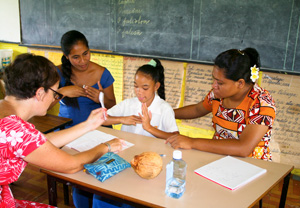The World Report on Disability, launched by the World Health Organization and the World Bank in New York on 9 June 2011, makes important recommendations for government action to support people living with disabilities. The report also highlights Australia's Development for All strategy as a best practice model of disability inclusive development.
Mr Gary Quinlan, Ambassador and Permanent Representative of Australia to the United Nations, represented Australia at the launch reinforcing Australia's commitment to integrating disability into all aspects of Australia's international aid program.
The World Report on Disability is the first ever report to review the best available scientific evidence on the situation of people with disabilities worldwide, exploring issues such as health, education, employment, discrimination and data collection.
The report suggests that more than a billion people, or approximately 15 per cent of the world's population, are living with a disability–of whom nearly 200 million experience considerable difficulties functioning.
Globally, people with disabilities experience poorer health outcomes, lower levels of education, less economic participation and higher rates of poverty than people without disabilities. This is partly because people with disabilities face barriers in accessing services including health, education, employment, transport, and information. These difficulties are exacerbated in less advantaged communities.
The report showcases successful approaches that have improved the lives of people with disabilities, while highlighting the need for continued and improved research and data on disability.
The report provides a number of key recommendations for governments, development organisations and the United Nations to improve the lives of people with disabilities. Some of these recommendations include:
- investing in specific programs and services for people with disabilities
- adopting national disability strategies and plans of action
- involving people with disabilities in community participation and decision making
- increasing public awareness and understanding of disability
- improving disability data collection
- strengthening and supporting research on disability.
Australia is one of the main donors to the report and a strong contributor to the World Health Organization's (WHO's) work on disability through a three year $4 million partnership (2011–2014). One of the aims of the partnership is to communicate the outcomes of the report and use it as a tool to encourage further action and collaboration on disability inclusive development.
Through the partnership, AusAID and WHO will also strengthen health and rehabilitation services for people living with disabilities.
Australia's disability strategy
A recent progress report shows that Australia's disability strategy is having a real impact. We are improving the reach of the aid program and people with disability are now benefitting from Australia's development assistance.
- In Samoa, girls and boys with hearing impairments are now able to go to secondary school and prepare for a career.
- In East Timor, the government has expanded community based rehabilitation so that people with disability can participate fully in community life.
- In Solomon Islands, people with disability are now able to use the new Auki Courthouse and registry because of a ramp and better bathroom and kitchen facilities.
- In Cambodia, the government has developed disability rights legislation which now forms a solid legal basis to end discrimination.
- Increasing numbers of young people with disability are now taking advantage of scholarship opportunities to study in Australia.
The progress report, Development for All–Achievement Highlights, highlights these and other achievements of the first two years of the disability strategy for Australia's aid program.
More information
- Disability in Australia's aid program
- World Report on Disability [external site]
- CBM welcomes World Report on Disability [external site]
World Health Organization–What's disability to me? [external link]

